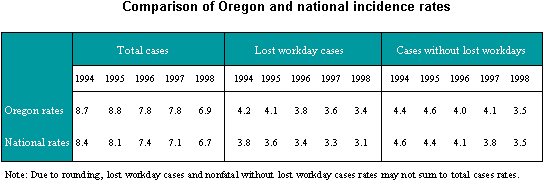
Private Sector Results – New Record
Low
Oregon workers employed in the private sector during calendar
year 1998 suffered work-related injuries and illnesses at a rate
of 6.9 for every 100 full-time employees. The 1998 total cases
incidence rate of 6.9 is the lowest ever recorded by the
private sector in Oregon. It is 21.6 percent lower than the average
rate of 8.8 for the period 1989-1998.
The 1998 lost workday cases incidence rate fell to 3.4, the lowest since the start of the survey in 1972. The rate of nonfatal cases without lost workdays decreased to 3.5, the lowest rate ever recorded. Compared to the 10-year average, the 1998 lost workday cases incidence rate decreased 19.0 percent while the rate of nonfatal cases without lost workdays decreased 22.2 percent.

Of the 78,062 total recordable cases in 1998, 49.5 percent resulted in lost worktime. An estimated 923,754 workdays were lost in Oregon’s private sector during 1998. This represents a 0.2 percent decrease from the 925,558 workdays lost in 1997.
Industry lost workday cases rates
The record low private sector lost
workday cases incidence rate of 3.4 is a 5.6 percent drop from
the previous record low of 3.6. Five industry divisions—agriculture,
forestry, and fishing; construction; transportation and public
utilities; wholesale trade; and retail trade—posted record
lows in 1998. Finance, insurance, and real estate remained at
its record low rate established in 1996.
The highest lost workday cases incidence rate of the industry divisions, 5.4, was recorded by the manufacturing industry. Finance, insurance, and real estate reported the lowest rate of 0.6. Transportation and public utilities reported the largest percentage decrease from 1997, dropping 38.7 percent to 4.6. The next largest percentage decrease came from mining, dropping 18.4 percent to 3.1. All other industries, except manufacturing and services, reported decreased or unchanged rates from 1997.

Public Sector Results
During 1998, the public sector reported a total cases incidence
rate of 6.0, the second lowest ever reported in Oregon. This
new rate represents a 3.2 percent decrease from the1997 rate
of 6.2. State government recorded a total cases rate of 4.7,
up 4.4 percent from the record low rate of 4.5 set in 1997. Local
government registered a rate of 6.5, the second lowest ever reported.
The 1998 rate represents a 5.8 percent decrease from the 1997
rate of 6.9.
The 1998 public sector lost workday cases incidence rate of 2.8 is 27.3 percent above the 1997 rate of 2.2. The 1998 rate consists of the state government lost workday cases rate of 2.1, and the local government rate of 3.1. The public sector logged an estimated 9,505 total recordable cases in 1998. Of these, 4,466 (47.0 percent) resulted in lost workdays. Lost workdays were estimated to be 93,046, up 25.6 percent from 74,110 days in 1997.
National Survey Results
The total cases incidence rate for the private sector nationwide
was 6.7 in 1998, down 5.6 percent from 7.1 in 1997, and a new
record low. The lost workday cases incidence rate decreased 6.1
percent to 3.1, the lowest rate ever recorded. The incidence
rate for nonfatal cases without lost workdays fell 7.9 percent
to 3.5. The Oregon total cases incidence rate and lost workday
cases incidence rate exceed the national rates by 3.0 and 9.7
percent, respectively. For the first time, the Oregon cases without
lost workdays incidence rate matched the national figure. Historically,
Oregon has tended to register higher incidence rates than the
national average.

Data in this summary are based upon the annual Occupational Safety and Health (OSH) survey which collects data from a scientifically selected sample of employer establishments across the state. This should be distinguished from the data collected from workers’ compensation claims submitted to the department by insurers.
For further information, or to order the 1998 Oregon Occupational Injury and Illness publication, please call the Oregon Department of Consumer & Business Services, Research & Analysis Section at (503) 378-8254.
If you have questions about the information contained in this document please contact by e-mail or phone: Lori Miller, Research Analyst, Research & Analysis Section, Information Management Division (503) 947-7195.
This document was originally published in April 2000.
[Printed form: 440-2081(04/00/IMD)]
In compliance with the Americans with Disabilities
Act (ADA), this publication is available in alternative formats
by calling (503) 378-4100 (V/TTY).
The information in IMD publications is in the public domain and
may be reprinted without permission.